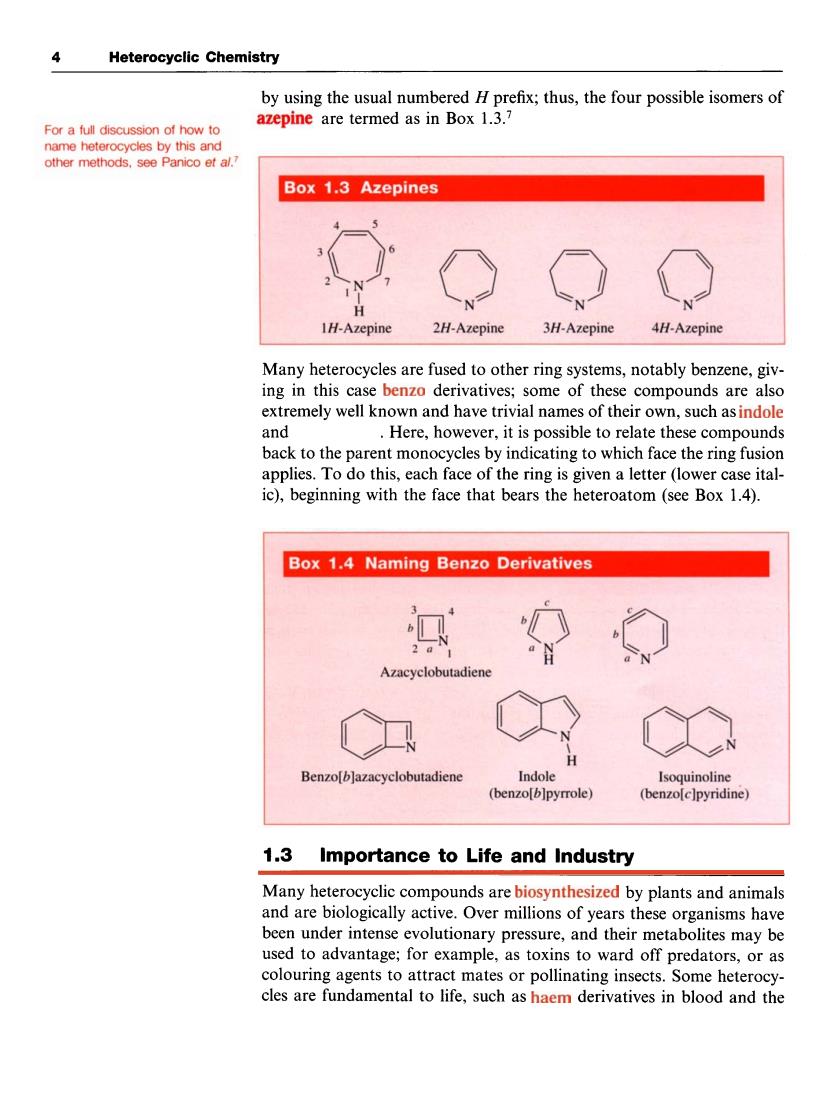正在加载图片...

4 Heterocyclic Chemistry by using the usual numbered H prefix;thus,the four possible isomers of For a full discussion of how to azepine are termed as in Box 1.3. Box 1.3 Azepines 1H-Azepine 2H-Azepine 3H-Azepine 4H-Azepine Many heterocycles are fused to other ring systems,notably benzene,giv ing in this case benzo derivatives;some of these compounds are also extremely well known and have trivial names of their own,such asindole and Here,however,it is possible to relate these compounds back to the parent monoeycles by indicating to which face the ringfusion applies.To do this,each face of the ring is given a letter (lower case ital- ic),beginning with the face that bears the heteroatom (see Box 1.4). Box 1.4 Naming Benzo Derivatives 河 Azacyclobutadiene Benzo[b]azacyclobutadiene Indole (benzo[b]pyrrole) ge 1.3 Importance to Life and Industry Many heterocyclic compounds are biosynthesized by plants and animals and are biologically active.Over millions of years these organisms have been under intense evolutionary pressure,and their metabolites may be used to advantage;for example as toxins to ward off predators,or as colouring agents to attract mates or pollinating insects.Some heterocy- cles are fundamental to life,such as haem derivatives in blood and the 4 Heterocyclic Chemistry by using the usual numbered H prefix; thus, the four possible isomers of azepine are termed as in Box 1 .3.7 For a full discussion of how to name heterocycles by this and other methods, see Panico et a/.7 Many heterocycles are fused to other ring systems, notably benzene, giving in this case benzo derivatives; some of these compounds are also extremely well known and have trivial names of their own, such as indole and isoquinoline. Here, however, it is possible to relate these compounds back to the parent monocycles by indicating to which face the ring fusion applies. To do this, each face of the ring is given a letter (lower case italic), beginning with the face that bears the heteroatom (see Box 1.4). 1.3 Importance to Life and Industry Many heterocyclic compounds are biosynthesized by plants and animals and are biologically active. Over millions of years these organisms have been under intense evolutionary pressure, and their metabolites may be used to advantage; for example, as toxins to ward off predators, or as colouring agents to attract mates or pollinating insects. Some heterocycles are fundamental to life, such as haem derivatives in blood and the